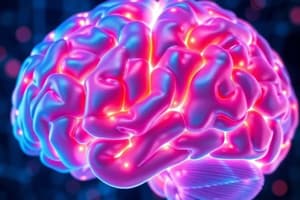Podcast
Questions and Answers
What is the term for the brain's ability to change and adapt throughout life in response to new experiences, environments, and learning?
What is the term for the brain's ability to change and adapt throughout life in response to new experiences, environments, and learning?
- Neuroplasticity (correct)
- Neuroadaptation
- Neurogenesis
- Neuroelasticity
Which type of neuroplasticity involves changes in the structure and function of individual neurons?
Which type of neuroplasticity involves changes in the structure and function of individual neurons?
- Neuronal plasticity (correct)
- Functional plasticity
- Synaptic plasticity
- Cognitive plasticity
What is the process by which synaptic connections are strengthened based on repeated stimulation?
What is the process by which synaptic connections are strengthened based on repeated stimulation?
- Long-term depression
- Neurotrophins
- Long-term potentiation (correct)
- Synaptic pruning
Which of the following factors can influence neuroplasticity?
Which of the following factors can influence neuroplasticity?
What is the clinical relevance of neuroplasticity in the context of brain injury?
What is the clinical relevance of neuroplasticity in the context of brain injury?
What is the implication of neuroplasticity for treatment and intervention in the context of brain disorders?
What is the implication of neuroplasticity for treatment and intervention in the context of brain disorders?
What is the term for proteins that promote neuronal growth and survival?
What is the term for proteins that promote neuronal growth and survival?
Which of the following is an example of a technique that promotes neuroplasticity?
Which of the following is an example of a technique that promotes neuroplasticity?
Study Notes
Neuroplasticity
Definition
- Neuroplasticity refers to the brain's ability to change and adapt throughout life in response to new experiences, environments, and learning.
Types of Neuroplasticity
- Synaptic plasticity: Strengthening or weakening of connections between neurons.
- Neuronal plasticity: Changes in the structure and function of individual neurons.
- Functional plasticity: Changes in brain function and organization.
Mechanisms of Neuroplasticity
- Long-term potentiation (LTP): Strengthening of synaptic connections based on repeated stimulation.
- Long-term depression (LTD): Weakening of synaptic connections based on reduced stimulation.
- Neurotrophins: Proteins that promote neuronal growth and survival, such as BDNF (brain-derived neurotrophic factor).
Factors that Influence Neuroplasticity
- Experience and learning: Novel experiences and learning new skills can lead to changes in brain structure and function.
- Exercise and physical activity: Regular exercise has been shown to promote neuroplasticity.
- Sleep and relaxation: Adequate sleep and stress reduction can facilitate neuroplasticity.
Clinical Relevance of Neuroplasticity
- Recovery from brain injury: Neuroplasticity allows for compensation and recovery after brain damage.
- Learning and memory: Neuroplasticity is essential for learning and memory formation.
- Psychiatric and neurological disorders: Abnormalities in neuroplasticity have been implicated in various disorders, such as depression and Alzheimer's disease.
Implications for Treatment and Intervention
- Rehabilitation and therapy: Targeting neuroplasticity can enhance treatment outcomes for brain disorders.
- Neurofeedback and cognitive training: Techniques that promote neuroplasticity can improve cognitive function and behavior.
- Pharmacological interventions: Certain medications can influence neuroplasticity and improve treatment outcomes.
Neuroplasticity
Definition
- Neuroplasticity is the brain's ability to change and adapt throughout life in response to new experiences, environments, and learning.
Types of Neuroplasticity
- Synaptic plasticity: The strengthening or weakening of connections between neurons based on experience.
- Neuronal plasticity: Changes in the structure and function of individual neurons.
- Functional plasticity: Changes in brain function and organization.
Mechanisms of Neuroplasticity
- Long-term potentiation (LTP): Strengthening of synaptic connections based on repeated stimulation, leading to long-lasting enhancement of neuronal communication.
- Long-term depression (LTD): Weakening of synaptic connections based on reduced stimulation, leading to long-lasting decrease in neuronal communication.
- Neurotrophins: Proteins that promote neuronal growth and survival, such as BDNF (brain-derived neurotrophic factor), which plays a crucial role in synaptic plasticity.
Factors that Influence Neuroplasticity
- Experience and learning: Novel experiences and learning new skills can lead to changes in brain structure and function, particularly in the hippocampus and neocortex.
- Exercise and physical activity: Regular exercise has been shown to promote neuroplasticity by increasing BDNF and promoting synaptic plasticity.
- Sleep and relaxation: Adequate sleep and stress reduction can facilitate neuroplasticity by reducing inflammation and promoting neuronal growth.
Clinical Relevance of Neuroplasticity
- Recovery from brain injury: Neuroplasticity allows for compensation and recovery after brain damage, such as in stroke or traumatic brain injury.
- Learning and memory: Neuroplasticity is essential for learning and memory formation, particularly in the hippocampus and neocortex.
- Psychiatric and neurological disorders: Abnormalities in neuroplasticity have been implicated in various disorders, such as depression, Alzheimer's disease, and schizophrenia.
Implications for Treatment and Intervention
- Rehabilitation and therapy: Targeting neuroplasticity can enhance treatment outcomes for brain disorders, such as cognitive training and non-invasive brain stimulation.
- Neurofeedback and cognitive training: Techniques that promote neuroplasticity can improve cognitive function and behavior, particularly in attention and executive function.
- Pharmacological interventions: Certain medications can influence neuroplasticity and improve treatment outcomes, such as antidepressants and cognitive-enhancing drugs.
Studying That Suits You
Use AI to generate personalized quizzes and flashcards to suit your learning preferences.
Description
Understand the concept of neuroplasticity, including its types and mechanisms, and how it affects brain function and organization. Quiz yourself on the brain's ability to adapt and change throughout life.




